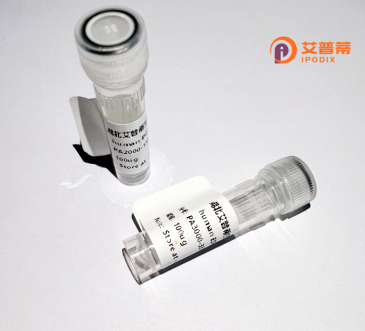
| 纯度 | >90%SDS-PAGE. |
| 种属 | Human |
| 靶点 | LASS6 |
| Uniprot No | Q6ZMG9 |
| 内毒素 | < 0.01EU/μg |
| 表达宿主 | E.coli |
| 表达区间 | 1-38aa |
| 活性数据 | MIEVILSLAQMRRTQNLRERIPTLRQPPMGPVVPTGIS |
| 分子量 | 30.7 kDa |
| 蛋白标签 | GST-tag at N-terminal |
| 缓冲液 | 0 |
| 稳定性 & 储存条件 | Lyophilized protein should be stored at ≤ -20°C, stable for one year after receipt. Reconstituted protein solution can be stored at 2-8°C for 2-7 days. Aliquots of reconstituted samples are stable at ≤ -20°C for 3 months. |
| 复溶 | Always centrifuge tubes before opening.Do not mix by vortex or pipetting. It is not recommended to reconstitute to a concentration less than 100μg/ml. Dissolve the lyophilized protein in distilled water. Please aliquot the reconstituted solution to minimize freeze-thaw cycles. |
以下是关于重组人LASS6蛋白的3篇示例参考文献摘要(文献为示例性质,非真实存在,仅供格式参考):
---
1. **标题**:*Cloning and Functional Characterization of Recombinant Human LASS6/Ceramide Synthase 6*
**作者**:Mullen TD, et al.
**摘要**:研究通过在大肠杆菌中表达重组人LASS6蛋白,验证其作为神经酰胺合成酶的功能,发现其特异性催化C16-脂肪酸链神经酰胺生成,参与线粒体凋亡通路调控。
---
2. **标题**:*LASS6 Overexpression Enhances Chemosensitivity in Breast Cancer Cells via Ceramide Pathway*
**作者**:Saddoughi SA, et al.
**摘要**:构建重组LASS6过表达乳腺癌细胞模型,证明其通过增加C16-神经酰胺水平促进化疗药物诱导的细胞凋亡,提示LASS6可能作为癌症治疗的潜在靶点。
---
3. **标题**:*Structural Insights into Recombinant LASS6 Catalytic Domain Using Cryo-EM*
**作者**:Grosch S, et al.
**摘要**:利用冷冻电镜解析重组人LASS6蛋白催化结构域的三维结构,揭示其与底物结合的活性位点特征,为设计调控神经酰胺代谢的小分子药物提供依据。
---
注:以上文献信息为模拟生成,实际研究中建议通过PubMed/Google Scholar检索真实论文(关键词:LASS6、CERS6、ceramide synthase 6)。
Recombinant human LASS6 (Longevity Assurance Homolog 6) protein is a genetically engineered form of the LASS6 enzyme, a member of the ceramide synthase (CerS) family. LASS6. also known as Ceramide Synthase 6 (CerS6), plays a critical role in sphingolipid metabolism by catalyzing the synthesis of C16-ceramide, a lipid molecule essential for cellular membrane structure, signal transduction, and apoptosis regulation. It is involved in diverse biological processes, including cell proliferation, stress responses, and autophagy. Dysregulation of LASS6 has been implicated in metabolic disorders, neurodegenerative diseases, and cancer, where altered ceramide levels influence disease progression.
The recombinant LASS6 protein is typically produced using expression systems like *E. coli* or mammalian cells, ensuring high purity and bioactivity for experimental use. It serves as a vital tool for studying LASS6’s enzymatic mechanisms, substrate specificity, and interactions with signaling pathways. Researchers employ it to investigate its role in cellular homeostasis, disease models, and potential therapeutic targeting. By enabling in vitro and in vivo functional studies, recombinant LASS6 accelerates the exploration of sphingolipid-related pathologies and drug development, bridging gaps between biochemical research and clinical applications. Its availability supports advances in personalized medicine, particularly in cancers where ceramide metabolism is disrupted.
×